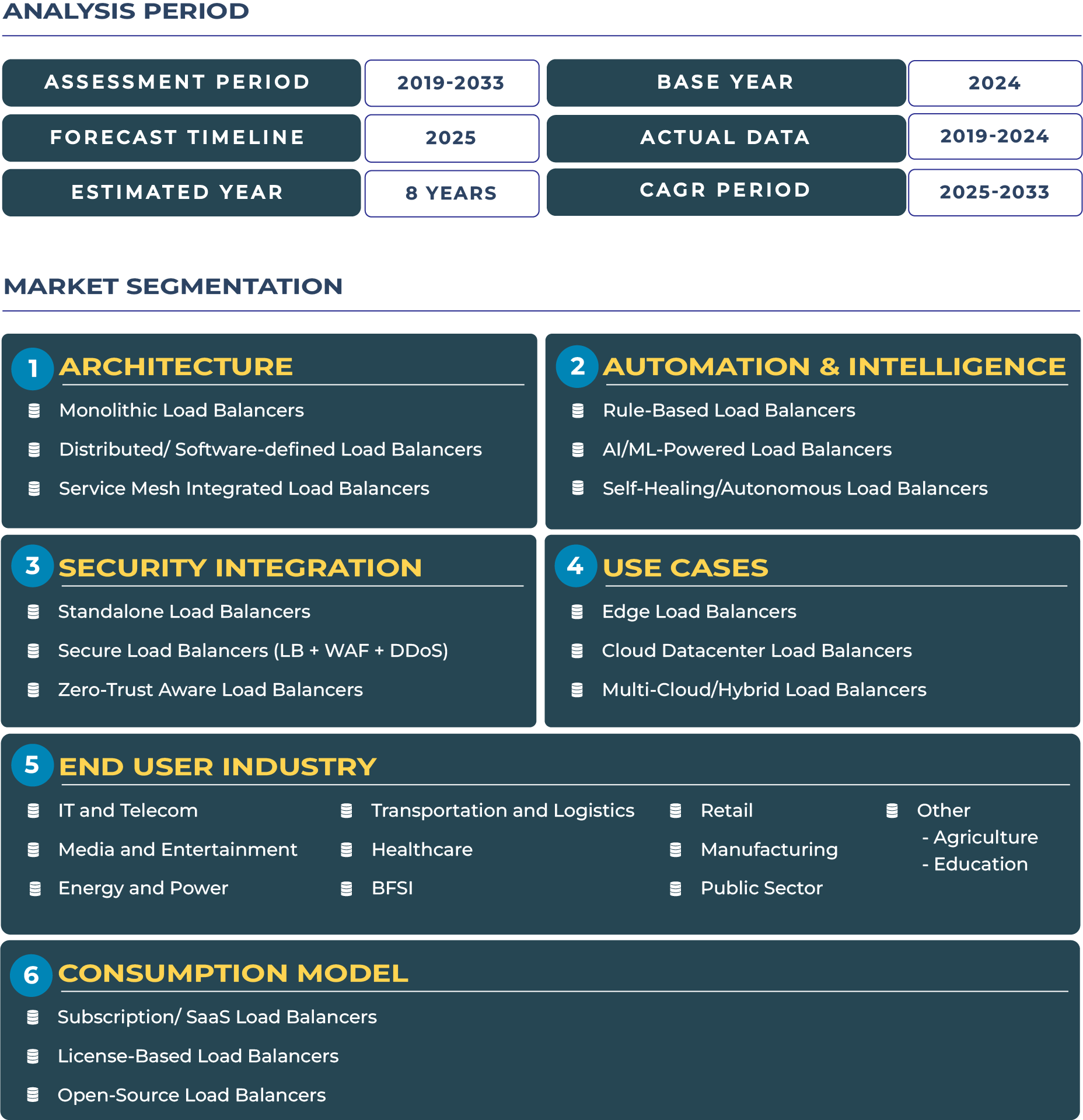Report Format:
![]()
![]() |
Pages: 110+
|
Pages: 110+
Digital Acceleration Amid Legacy IT Transition: Outlook of Italy Cloud Load Balancers Market
Italy is positioning itself as one of Europe’s fastest-accelerating markets transitioning from legacy IT infrastructures to cloud-first adoption, and this shift is fueling growth in the cloud load balancers ecosystem. With businesses, especially small and medium-sized enterprises (SMEs), modernizing digital operations under EU-supported investments and government incentives, the market is seeing strong momentum. In 2025, the Italy Cloud Load Balancers Market is estimated to reach USD 64.8 million and is forecasted to grow to USD 191.9 million by 2033, achieving a compound annual growth rate (CAGR) of 14.5% during 2025–2033. The surge is linked to demand for secure, scalable, and high-performing architectures, where distributed and software-defined load balancers are increasingly deployed by enterprises balancing agility with cost efficiency. This digital push highlights Italy’s efforts to close legacy IT gaps while strengthening resilience across its digital economy.
Government-Backed Digitization and SME Expansion as Primary Growth Catalysts
One of the strongest growth drivers of the Italy cloud load balancers industry is the government’s national digitalization strategy, which emphasizes cloud adoption in public administration and enhanced cyber resilience. SMEs, which represent more than 90% of Italian enterprises, are adopting scalable cloud workloads to reduce costs and modernize customer-facing applications, directly driving demand for load balancing solutions. Additionally, the growing penetration of financial technology services and banking workloads across regions such as Milan and Rome amplifies the demand for secure and distributed traffic management. Furthermore, service mesh integrated load balancers are gaining traction among enterprises building multi-cloud and microservices-driven applications. These structural shifts highlight why the Italian market is becoming central to Europe’s SME-focused digital ecosystem.
Economic Headwinds and Regional Digital Divide Acting as Barriers
Despite its growth trajectory, the Italy cloud load balancers sector faces notable challenges. Macroeconomic slowdowns, higher inflationary pressures, and geopolitical uncertainties in Europe are slowing IT spending among some enterprises. Furthermore, Italy’s regional digital divide, with southern regions lagging behind northern hubs such as Lombardy and Emilia-Romagna, results in uneven adoption of advanced IT infrastructure. Limited hyperscaler presence beyond major metropolitan areas further restricts uniform deployment of sophisticated load balancing solutions. While distributed load balancers reduce complexity in hybrid deployments, adoption remains inconsistent due to infrastructure constraints. These barriers underscore why consistent policy support, balanced regional investments, and stronger hyperscaler footprints are vital for market expansion.
Shaping the Future: Emerging Trends and High-Potential Opportunities
Several transformative trends are reshaping the Italy cloud load balancers landscape. SME-targeted cloud services are expanding rapidly, with cloud-native applications dominating business models for retail, logistics, and fintech sectors. The BFSI sector is undergoing modernization, demanding resilient traffic management frameworks to handle real-time financial workloads securely. At the same time, government-backed IT digitization initiatives are accelerating adoption across e-services, healthcare, and education platforms. Opportunities are particularly strong in SME SaaS adoption, where service mesh integrated load balancers are ensuring reliable microservices performance. In addition, banking-driven workloads and the digitization of public services supported by EU recovery funds are opening new avenues for cloud load balancer vendors to localize offerings for Italy’s evolving market.
Competitive Landscape: Strategic Moves Defining Italy Cloud Load Balancers Industry
The competitive landscape in Italy cloud load balancers ecosystem is witnessing aggressive strategies from both international hyperscalers and local technology players. In 2023, AWS expanded its footprint with investments in the Milan region, bolstering resilience for enterprises migrating mission-critical workloads. In 2024, Google Cloud partnered with TIM to enhance hybrid and multi-cloud offerings tailored to SME clients. Similarly, Microsoft Italy announced the launch of its Cloud Region in 2024, designed to provide localized data compliance and advanced cloud-native services. These moves are aimed at tapping into Italy’s SME digital ecosystem, which forms the backbone of national economic transformation. Beyond hyperscalers, distributed load balancer providers are targeting integration with service mesh frameworks to gain traction among enterprises adopting Kubernetes-driven deployments.







